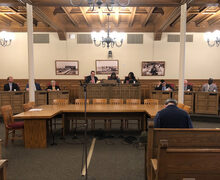How the Erie Canal made Syracuse what it is today
Casey Russell | Head Illustrator
Without the Erie Canal, Syracuse University may not exist today.
The construction of the canal 200 years ago redefined Syracuse and New York state as a whole and affected nearly every region in the United States. To commemorate the bicentennial of the canal, Samuel Clemence, a former professor of civil engineering at SU and an Erie Canal expert, will deliver the lecture, “The Engineering History of the Erie Canal,” on Sunday.
Clemence, who gives the lecture “to preserve the memory” of the canal, first learned about the canal when he was a fifth-grader in Atlanta. When he moved to Syracuse he took a visit to the canal. Fascinated by its history, he took on the task of documenting its journey and got to work on what is now a regularly scheduled lecture at SU.
“(The Erie Canal is) a great part of our history that’s been overlooked,” Clemence said.
Built between 1817 and 1825, the canal paved the way for commercial prosperity and job opportunities in cities across the country, and Syracuse in particular. In the early 19th century, the canal was the equivalent of Silicon Valley. But the importance of the canal is often forgotten and overlooked.
Before the canal, Syracuse was a low-lying backwater town that was a major producer of salt. But the salt was too expensive to transport, so economic growth was largely limited.
During the Civil War, this salt economy saw a surge. Food transported from the North to the South was preserved in salt — which came from Syracuse — and became accessible and easy to transport because of the Erie Canal.
The canal gave rise to the concept of “boom towns,” said Cynthia Van Ness, director of library and archives at the Buffalo History Museum, in the documentary “Erie: The Canal That Made America.”
“People were pouring in and business was booming, and there were job opportunities so they’d end up in Syracuse or Rochester or Buffalo working and knitting themselves into the community,” Van Ness said. “So, that is part of the canal’s draw as well is that it creates boom towns.”
Before its construction, New Orleans was the leading port in the country since it was at the mouth of the Mississippi River, Clemence said. The canal created a backbone for the fortunes of the country, making New York City the commercial hub it still is today, said David Muir in the documentary. Muir is the anchor of “ABC World News.”
Today, vestiges of the canal can be seen in Syracuse’s Clinton Square and Erie Boulevard, which was at one point part of the canal.
“If you’re traveling on Erie Boulevard, then you’re traveling on the canal,” Clemence said.
At Cedar Bay Park, visitors can walk or cycle along the path or even cross-country ski along what was once the canal.
Geddes Street is another such vestige, though not part of the canal. Named after James Geddes, a self-trained engineer and Syracuse resident, he was one of the five engineers chosen for the supervision of construction of the canal. Formerly a salt manufacturer in Syracuse, Geddes was a major proponent of the canal who also laid down its route.
For those new to Syracuse, the canal likely rings a bell because of the Erie Canal Museum located on Erie Boulevard, inside the 1850 Weighlock Building.
“When they first built the canal they charged a fare,” Clemence said. “ … For every boat that went through, you had to pay for the canal, and so the boats would detour inside this building where they would weigh it on an underwater scale.”
There were 10 to 12 of these Weighlock buildings, he added, but only the one in Syracuse was preserved.
Like Clemence, Linsey Armstrong, a first-year public diplomacy graduate student at SU, visited the museum when she moved to Syracuse from Nebraska.
“I think while you’re here at Syracuse it’s important to learn about the town and the city that you’re living in and how it came to be,” Armstrong said. “And the Erie Canal was, I’d say, one of the No.1 motivators for the city becoming what it is.”
Published on September 19, 2017 at 10:59 pm
Contact Rhea: rhbhambh@syr.edu





